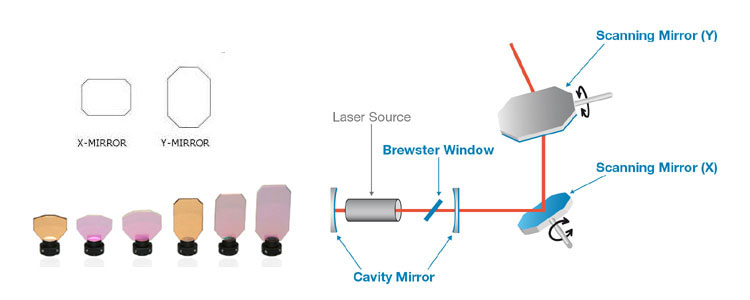Explore the most up to date Developments in Galvo Scanner Technology
Explore the most up to date Developments in Galvo Scanner Technology
Blog Article
A Comprehensive Overview to Various Types of Galvo Scanners and Their Applications
Galvo scanners, known for their rate and precision, are essential to a variety of industries from producing to clinical modern technology. This overview will explore the different types, such as dual-axis and single-axis scanners, each customized for certain jobs and intricacies. As we browse via the crucial considerations and one-of-a-kind attributes, you'll get insight right into just how these scanners boost effectiveness and precision in their respective applications. The trip to choosing the optimal galvo scanner for your functional requirements begins with recognizing these subtleties. So, how do these various types satisfy diverse commercial needs?
Standard Review of Galvo Scanners
Galvo scanners, short for galvanometer scanners, are precision tools made use of to route laser beams precisely and quickly across a designated location. Basically, a galvo scanner is composed of a small, light-weight mirror affixed to a galvanometer, which is an electromechanical device that measures electrical current by deflection of a needle.
The core principle behind galvo scanners is the precise and rapid control of the mirror's angle, which consequently changes the instructions of the laser light beam. This is attained via a closed-loop responses system that makes certain the mirror's placement is constantly checked and readjusted for precision. The feedback system makes up setting sensing units, control electronic devices, and high-performance motors, providing remarkable responsiveness and accuracy.
Galvo scanners succeed in applications calling for recurring and intricate laser activities, such as laser engraving, reducing, and clinical imaging. Their capacity to operate at high speeds without giving up precision makes them indispensable in scenarios requiring both efficiency and accuracy.
Kinds Of Galvo Scanners
When discovering the kinds of galvo scanners, it's critical to comprehend that variations are primarily based on their layout, application requirements, and performance requirements. Usually, galvo scanners can be categorized into dual-axis and single-axis models.
Dual-axis galvo scanners, on the various other hand, give two-dimensional control of the light course. This makes them vital in more complicated applications like laser light shows, 3D printing, and clinical imaging. Dual-axis versions are generally equipped with 2 mirrors and matching galvanometers, enabling dynamic control over both X and Y works with.

Key Attributes to Consider
When selecting a galvo scanner for your particular application,Numerous key functions must be diligently evaluated. Rate is a crucial characteristic, as it identifies the scanner's ability to manage high-frequency jobs effectively. The speed is usually gauged in regards to feedback time and the optimum number of points per 2nd the scanner can address.

An additional crucial feature is the scanner's variety of activity, which indicates the maximum angular deviation it can accomplish. A broader range offers higher versatility yet may require extra advanced control systems. Thermal stability likewise requires interest, as temperature changes can impact performance; therefore, choose scanners with robust thermal management systems.
Industry-Specific Applications
In various industries, galvo scanners play a crucial duty by enhancing accuracy and efficiency in specialized applications. In the clinical area, galvo scanners are indispensable to laser surgical treatments and ophthalmic treatments, where high-speed, exact light beam positioning is vital. These tools enable minimally intrusive surgeries by exactly targeting cells, therefore minimizing recuperation times and boosting individual end results.
In production, galvo scanners are crucial for laser engraving, cutting, and welding. Their capacity to quickly and precisely straight laser light beams guarantees high-quality finishes and detailed describing, which is essential for the production of complicated elements in vehicle, aerospace, and electronic devices markets. The fabric sector likewise takes advantage of galvo scanners in textile cutting and inscription, using both rate and precision in processing varied materials.

Choosing the Right Galvo Scanner
Picking the ideal galvo scanner is a crucial choice that hinges on several crucial variables, consisting of application requirements, efficiency requirements, and budget restrictions. Plainly specify the application needs. Whether the scanner is planned for laser inscription, clinical imaging, or 3D printing, each application requires particular performance attributes such as precision, speed, and resolution.
Second, take into consideration the performance specs. Specifications like scan angle, reaction time, and thermal security are essential (galvo scanner). A high-speed galvo scanner with a broad scan read the article angle is excellent for large-area marking, while applications calling for fine information might prioritize high resolution and accuracy
Third, account for budget restrictions. High-performance galvo scanners feature a considerable investment, however their long-term advantages can outweigh preliminary expenses. Review the overall expense of possession, consisting of upkeep, to guarantee the selected scanner supplies value over its life expectancy.
Verdict
Comprehending the varied kinds of galvo scanners and their one-of-a-kind capabilities is essential for maximizing efficiency across numerous industries. Single-axis and dual-axis designs cater to different functional complexities, while high-speed and high-precision versions address specific needs in manufacturing, textiles, medical fields, and 3D printing. Careful choice based on the one-of-a-kind features and application needs of each kind of galvo scanner makes sure enhanced efficiency and accuracy, therefore dramatically boosting general operational outcomes.
Galvo scanners, short for galvanometer scanners, are precision devices utilized to route laser beam of lights accurately and swiftly throughout an assigned area.When exploring the kinds of galvo scanners, it's crucial to recognize that variants are mostly based on their layout, application requirements, and performance specs. Each kind of galvo scanner is hence uniquely tailored to meet details functional needs, making certain ideal performance throughout numerous applications.
The precision of a galvo scanner directly influences the quality of the output, making it necessary to consider the scanner's capacity to keep high-resolution efficiency (galvo scanner). Mindful option based on the distinct attributes and application demands of each kind of galvo scanner makes sure boosted efficiency and precision, therefore considerably enhancing total operational end results
Report this page